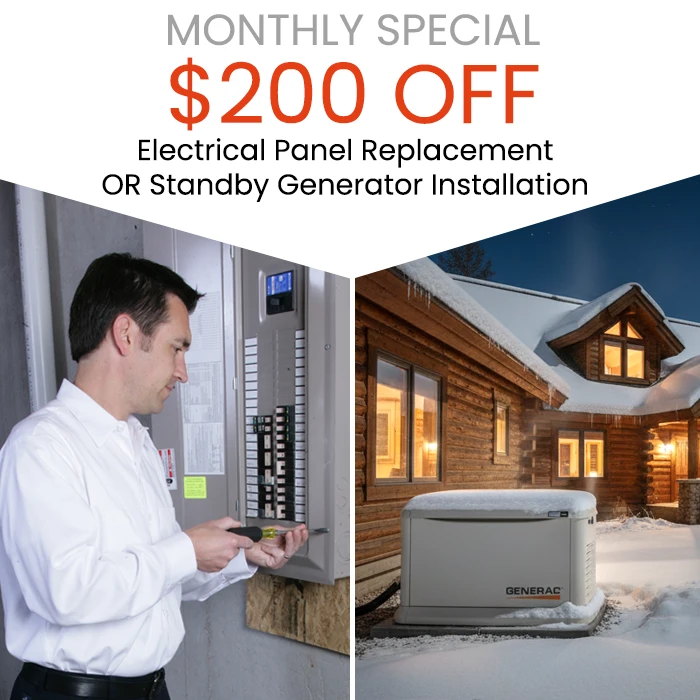
Winter in northwest Montana is not just about snow and cold, it’s also a season of heavy electrical use. As temperatures drop, we rely on space heaters, furnace blowers, lights, and appliances more than any other time of year. In fact, just last year during a January cold snap in Kalispell when the thermometer plummeted to –33°F, Flathead Electric Cooperative recorded a record peak demand of 441.9 megawatts on the grid. That extreme example shows how much harder your home’s electrical system works in winter. All this extra demand can put significant strain on your electrical panel, which is the heart of your home’s power distribution. If your panel or wiring is older or already near capacity, the winter load can push it to its limits.
Why does winter push your electrical system so hard? Consider all the ways we use more electricity during the colder months. Below are some of the most common causes of increased electrical load in Flathead Valley homes each winter:
Common Winter Electrical Loads That Strain Your Panel
- Electric heating systems: Homes with electric furnaces, baseboard heaters, or heat pumps will see a big jump in power use when it’s cold. Even gas furnaces use electricity for blowers and controls, so virtually every heating system draws power in winter.
- Portable space heaters: Those little plug-in heaters are notorious power hogs. Each space heater can draw about 1,500 watts on high (roughly the same as running a hair dryer continuously). Running multiple space heaters or forgetting them on all day can easily overload circuits and spike your energy use.
- Additional lighting: Winter’s shorter days and long nights mean lights stay on longer. Indoor and outdoor lights are used more extensively, from lamps and overhead fixtures to porch lights that kick on early. This extended lighting time increases the electrical load compared to summer months.
- More time indoors – more appliance use: When it’s freezing outside, we spend more time inside cooking, working, and entertaining. Ovens, microwaves, televisions, computers, and other electronics get heavier use during winter, adding to the overall power demand. Think of holiday cooking marathons and daily use of electric blankets or humidifiers… it all adds up.
- Holiday lights and décor: Festive Christmas lights, brightly lit yard decorations, and other holiday displays can draw a surprising amount of power, especially if you have many strands of older incandescent lights. They might be on for hours each night, contributing to the strain on your electrical panel. Modern LED holiday lights use less energy, but large displays can still have a noticeable impact.
- Overuse of extension cords and power strips: With limited outlets, many homeowners resort to power strips and extension cords to plug in all their winter gadgets and decorations. Plugging too many devices into one outlet or daisy-chaining extension cords is dangerous, the cords can overheat and even cause a fire if overloaded. Heavy reliance on extension cords or surge protectors often means your home’s wiring isn’t keeping up with your needs, forcing the electrical panel to work harder to distribute power.
All these factors combine to create a “perfect storm” of electrical demand in winter. If your home has an older or undersized panel, these extra draws can expose its weaknesses. You might start noticing signs that your electrical system is struggling. It’s important to pay attention to those warning signs and address them before they lead to bigger problems.
When to Call an Electrician
How do you know if your electrical panel is overwhelmed or unsafe? Watch for these warning signs of trouble in your home’s electrical system, especially during the winter months:
- Flickering or dimming lights: Do your lights flicker when the heater kicks on or when you plug in a space heater? Lights that dim or flicker, particularly when major appliances or multiple devices are running, signal that circuits are near capacity.
- Warm or discolored outlets or switches: If an outlet or light switch feels warm to the touch, is becoming discolored/brown, or you notice sparking when plugging things in, that’s a serious red flag. Overloaded circuits or loose wiring connections could be overheating behind the wall.
- Frequently tripping breakers (or blown fuses): It’s normal for a circuit breaker to trip occasionally – that’s how it protects your home. But it shouldn’t be a common occurrence. If you find yourself resetting breakers often (or replacing fuses in an older fuse box), your electrical panel might not be handling the load. Constant tripping means the circuit is drawing more current than it safely can, a sure sign of overload.
- Burning smells or scorch marks: A persistent burning plastic smell, or any odor of overheating electrical components, is cause for immediate concern. It often means wires or outlets are overheating and melting their insulation. Likewise, charring or brown/black scorch marks around an outlet, plug, or the electrical panel indicate past overheating or arcing. These symptoms are serious fire hazards and should never be ignored.
If you notice any of these warning signs in your Flathead Valley home, it’s time to take action. Electrical issues tend to get worse, not better, when left unchecked. Flickering lights or tripping breakers are not just annoyances, they are your panel needing a checkup. And a hot outlet or electrical burning smell is an urgent danger sign that could precede an electrical fire. Don’t wait for a minor issue to turn into a major problem.
Call the licensed electricians at Central as soon as possible if you experience these issues. A professional can inspect your electrical panel and wiring, identify the cause of the strain, and recommend solutions. This might involve redistributing loads, replacing faulty components, or upgrading an old panel to a newer, higher-capacity one. The good news is that taking action early can prevent power outages, equipment damage, and potential fires, keeping your family safe and warm.



